Trafficking of a ligand-receptor complex on the growth cones as an essential step for the uptake of nerve growth factor at the distal end of the axon: a single-molecule analysis
- PMID: 15745944
- PMCID: PMC6726083
- DOI: 10.1523/JNEUROSCI.4570-04.2005
Trafficking of a ligand-receptor complex on the growth cones as an essential step for the uptake of nerve growth factor at the distal end of the axon: a single-molecule analysis
Abstract
The behavior of single molecules of neurotrophins on growth cones was observed by the use of the fluorescent conjugate of nerve growth factor (NGF), Cy3-NGF. After the application of 0.4 nm Cy3-NGF, chick dorsal root ganglion growth cones responded within 1 min of adding the stimulus by expanding their lamellipodia. Only 40 molecules of Cy3-NGF, which occupied <5% of the estimated total binding sites on a single growth cone, were required to initiate the motile responses. After binding to the high-affinity receptor, Cy3-NGF displayed lateral diffusion on the membrane of the growth cones with a diffusion constant of 0.3 microm2 s(-1). The behavior of Cy3-NGF was shifted to a one-directional rearward movement toward the central region of the growth cone. The one-directional movement of Cy3-NGF displayed the same rate as the rearward flow of actin, approximately 4 microm/min. This movement could be stopped by the application of the potent inhibitor of actin polymerization, latrunculin B. Molecules of Cy3-NGF were suggested to be internalized in the vicinity of the central region of the growth cone during this rearward trafficking, because Cy3-NGF remained in the growth cone after the growth cones had been exposed to an acidic surrounding medium: acidic medium causes the complete dissociation of Cy3-NGF from the receptors on the surface of growth cones. These results suggested that actin-driven trafficking of the NGF receptor complex is an essential step for the accumulation and endocytosis of NGF at the growth cone and for the retrograde transport of NGF toward the cell body.
Figures

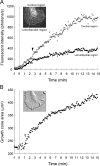
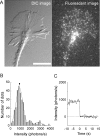


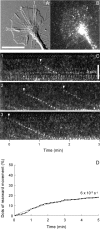

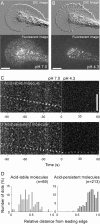
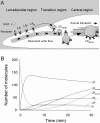
Similar articles
-
The dynein inhibitor Ciliobrevin D inhibits the bidirectional transport of organelles along sensory axons and impairs NGF-mediated regulation of growth cones and axon branches.Dev Neurobiol. 2015 Jul;75(7):757-77. doi: 10.1002/dneu.22246. Epub 2014 Nov 20. Dev Neurobiol. 2015. PMID: 25404503 Free PMC article.
-
Nerve growth factor and semaphorin 3A signaling pathways interact in regulating sensory neuronal growth cone motility.J Neurosci. 2002 Aug 1;22(15):6659-69. doi: 10.1523/JNEUROSCI.22-15-06659.2002. J Neurosci. 2002. PMID: 12151545 Free PMC article.
-
RhoA-kinase and myosin II are required for the maintenance of growth cone polarity and guidance by nerve growth factor.J Neurobiol. 2006 Jul;66(8):847-67. doi: 10.1002/neu.20258. J Neurobiol. 2006. PMID: 16673385 Free PMC article.
-
Growth cones integrate signaling from multiple guidance cues.J Histochem Cytochem. 2003 Apr;51(4):435-44. doi: 10.1177/002215540305100405. J Histochem Cytochem. 2003. PMID: 12642622 Review.
-
Mitochondrial movement and positioning in axons: the role of growth factor signaling.J Exp Biol. 2003 Jun;206(Pt 12):1985-92. doi: 10.1242/jeb.00263. J Exp Biol. 2003. PMID: 12756280 Review.
Cited by
-
Polarized light microscopy in reproductive and developmental biology.Mol Reprod Dev. 2015 Jul-Aug;82(7-8):548-62. doi: 10.1002/mrd.22221. Epub 2013 Aug 26. Mol Reprod Dev. 2015. PMID: 23901032 Free PMC article.
-
One at a time, live tracking of NGF axonal transport using quantum dots.Proc Natl Acad Sci U S A. 2007 Aug 21;104(34):13666-71. doi: 10.1073/pnas.0706192104. Epub 2007 Aug 14. Proc Natl Acad Sci U S A. 2007. PMID: 17698956 Free PMC article.
-
Modelling reaction kinetics inside cells.Essays Biochem. 2008;45:41-56. doi: 10.1042/BSE0450041. Essays Biochem. 2008. PMID: 18793122 Free PMC article. Review.
-
Tracking bio-molecules in live cells using quantum dots.J Biophotonics. 2008 Sep;1(4):287-98. doi: 10.1002/jbio.200810029. J Biophotonics. 2008. PMID: 19343652 Free PMC article. Review.
-
The trip of the tip: understanding the growth cone machinery.Nat Rev Mol Cell Biol. 2009 May;10(5):332-43. doi: 10.1038/nrm2679. Epub 2009 Apr 17. Nat Rev Mol Cell Biol. 2009. PMID: 19373241 Free PMC article. Review.
References
-
- Chao MV, Bothwell MA, Ross AH, Koprowski H, Lanahan AA, Buck CR, Sehgal A (1986) Gene transfer and molecular cloning of the human NGF receptor. Science 232: 518-521. - PubMed
Publication types
MeSH terms
Substances
LinkOut - more resources
Full Text Sources
Other Literature Sources
